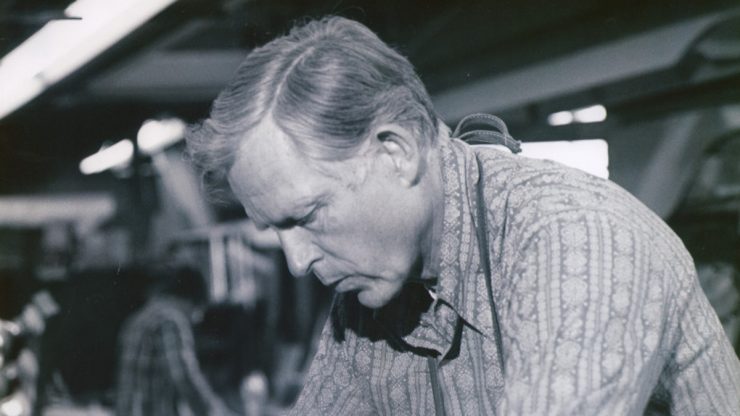Stanley Richard Pocock’s legacy spans some of the most successful decades of rowing at the University of Washington and extends from the UW boathouse across the Sound to the site of the future BIR boathouse on Bainbridge Island.
Stan Pocock learned the boat building trade from his father George who built racing shells for the University of Washington starting in 1913, including for the 1936 Olympic gold medal-winning U.S. team familiarly know as “The Boys in the Boat.” Stan graduated from high school with a vision for his life: Like his father he would dedicate himself to boat building.
At the University of Washington, he rowed for two years for Coach Al Ulbrickson. Then, when the draft was instituted during World War II, he joined the Navy and an officer-training program at the UW. He continued rowing while in the program, as the Navy decided that rowing would provide important physical training for the future officers.
After Pocock graduated with a degree in engineering, Ulbrickson hired him in 1948 as freshman rowing coach. Between 1950 and 1954, he coached the freshmen to win three national championships.
In 1954, he left the UW to join his father at Pocock Racing Shells. That’s where he began to experiment with design and construction. His work led to the development of the fiberglass oar, molded seat tops, ribless boats, and the adjustable oarlock spacer. He built the first all-fiberglass rowing boat in 1956.
 But Pocock wasn’t done with coaching. He coached crews that went on to win gold medals in the 1956 and 1960 Olympics. In 1958 he signed on as the first coach with the Lake Washington Rowing Club.
But Pocock wasn’t done with coaching. He coached crews that went on to win gold medals in the 1956 and 1960 Olympics. In 1958 he signed on as the first coach with the Lake Washington Rowing Club.
By the late 1960s, Pocock had taken on management of Pocock Racing Shells. In 1981 he developed the first line of carbon-fiber racing shells.
After George died in 1976, Stan, his sister Patricia, and their mother Frances established the George Pocock Rowing Foundation in support of youth rowing nationwide.
Pocock later wrote his autobiography. “Way Enough!”: Recollections of a Life in Rowing was published in 2000.
Pocock had three children with his wife of 40 years, Lois. After her death he remarried, this time to Suzanne Graves, who had three children of her own.
Stan and his father were inducted into the National Rowing Hall of Fame, George in 1966 and Stan in 1979. They are the only two men ever to have built Olympic gold-medal winning shells and coached Olympic gold-medal winning crews. In 2012, USRowing awarded Stan its Medal of Honor lifetime achievement award.
In 2017, Bainbridge Island Rowing announced in collaboration with Sue Pocock and the George Pocock Rowing Foundation that its boathouse, for which construction began in 2016, would be named after the master boatbuilder and coach. To help complete Pocock’s legacy through The Stan Pocock Legacy Rowing Center, click here. Read more about the project here.
Sources:
“Born into Rowing—Stan Pocock,” by Melissa Bray, December 2014, article published on World Rowing. http://www.worldrowing.com/news/born-into-rowing-stan-pocock
“George Pocock: The Godfather of American Rowing,” by Lenville O’Donnell, 2018, article published in The Sea Chest.
“A Legend Remembered: The Rowing World Says Goodbye to Stan Pocock,” by Bryan Kitch, February 2015, article published on Rowing News. http://www.rowingnews.com/a-legend-remembered-the-rowing-world-says-goodbye-to-stan-pocock/
“Rowing Legend Stan Pocock Passes Away at Age 91.” https://gohuskies.com/sports/2014/12/16/209810979.aspx





